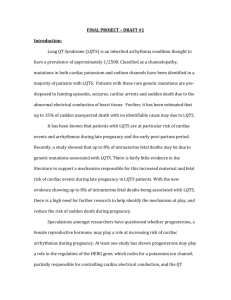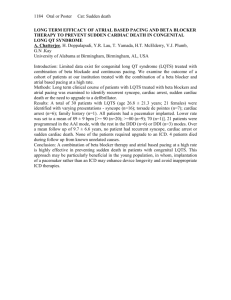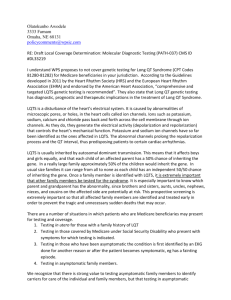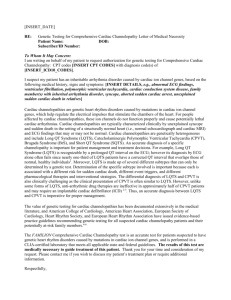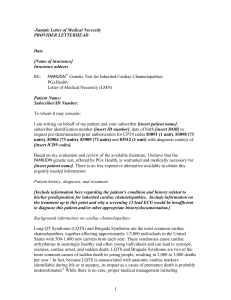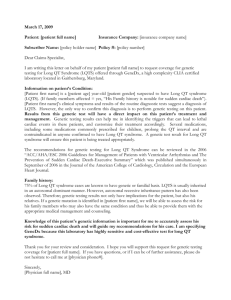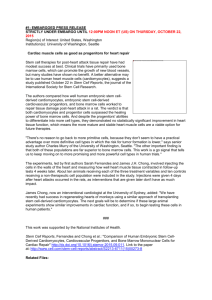Final Project – Brianna Davies
advertisement
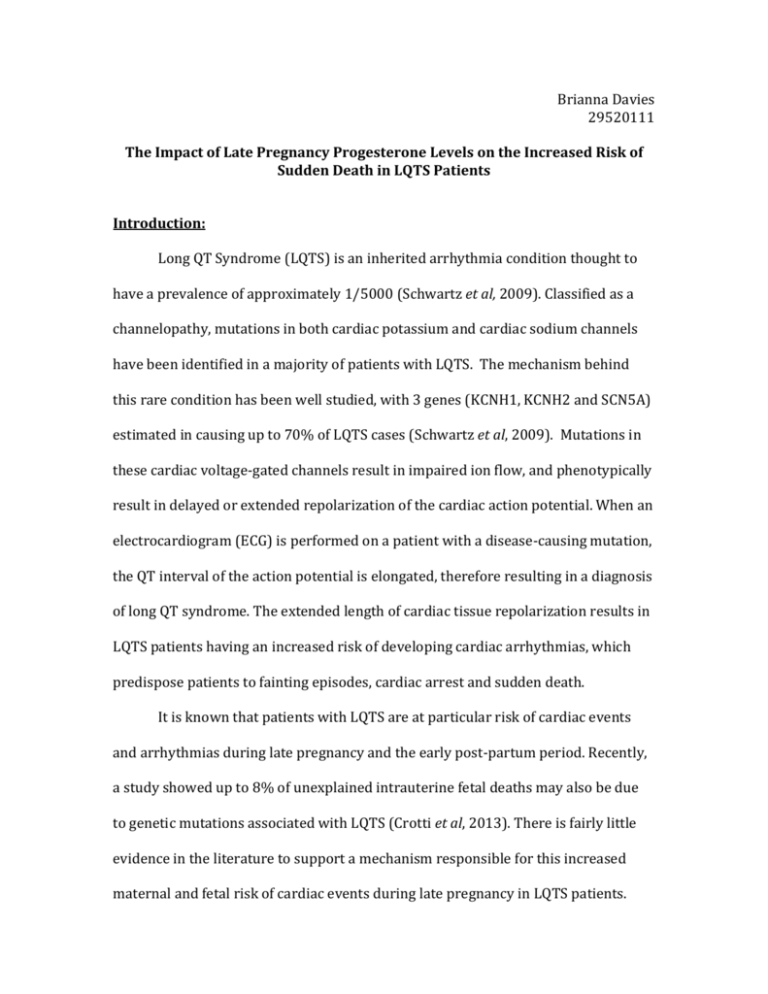
Brianna Davies 29520111 The Impact of Late Pregnancy Progesterone Levels on the Increased Risk of Sudden Death in LQTS Patients Introduction: Long QT Syndrome (LQTS) is an inherited arrhythmia condition thought to have a prevalence of approximately 1/5000 (Schwartz et al, 2009). Classified as a channelopathy, mutations in both cardiac potassium and cardiac sodium channels have been identified in a majority of patients with LQTS. The mechanism behind this rare condition has been well studied, with 3 genes (KCNH1, KCNH2 and SCN5A) estimated in causing up to 70% of LQTS cases (Schwartz et al, 2009). Mutations in these cardiac voltage-gated channels result in impaired ion flow, and phenotypically result in delayed or extended repolarization of the cardiac action potential. When an electrocardiogram (ECG) is performed on a patient with a disease-causing mutation, the QT interval of the action potential is elongated, therefore resulting in a diagnosis of long QT syndrome. The extended length of cardiac tissue repolarization results in LQTS patients having an increased risk of developing cardiac arrhythmias, which predispose patients to fainting episodes, cardiac arrest and sudden death. It is known that patients with LQTS are at particular risk of cardiac events and arrhythmias during late pregnancy and the early post-partum period. Recently, a study showed up to 8% of unexplained intrauterine fetal deaths may also be due to genetic mutations associated with LQTS (Crotti et al, 2013). There is fairly little evidence in the literature to support a mechanism responsible for this increased maternal and fetal risk of cardiac events during late pregnancy in LQTS patients. Speculations amongst researchers have questioned whether progesterone, a female reproductive hormone, may play a role in increasing risk of cardiac arrhythmias during pregnancy (Wu et al, 2011). At least one study has shown progesterone may play a role in the regulation of the HERG gene, also known as KCNH2. The HERG gene codes for a potassium ion channel, which plays a significant role in controlling cardiac electrical conduction and the QT interval (Wu et al, 2011). It has been shown that increased progesterone levels decreases trafficking of the HERG gene, resulting in lowered K+ flow and overall decreasing the rate of repolarization and QT interval (Wu et al, 2011). While the natural increase in progesterone levels may be relatively harmless in the general population, the increased levels in LQTS patients may further increase the QT interval in both mothers and their developing fetus, placing them in high risk of arrhythmias and sudden death. Further, progesterone is known to increase during the third trimester of pregnancy, therefore fitting with the increased risk of cardiac events and sudden death in LQTS patients during this period (Wu et al, 2011). Of the approximately 2.64 million stillbirths occurring worldwide each year, a cause of death is identified in only 60% of these cases (Crotti et al, 2011). With recent evidence suggesting up to 8% of these unexplained intrauterine deaths are due to LQTS, it is crucial for more research in this field in order to protect such a vulnerable population (Crotti et al, 2011). Experiment Proposal: In the past decade, the development of stem cell technology has rapidly changed the face of drug testing in the cardiac electrophysiology field. It is now possible to develop patient-specific cardiomyocytes from human induced pluripotent stem cells. These cardiomyocyte-like cells harbor the same genetic variants present in vivo, and provide an excellent new media for preforming expressivity and functional studies to observe the impact of these genetic variants. Recently, a paper by Matsa, et al showed the ability to create patient specific cardiomyocytes harboring LQTS mutations, and using multielectrode array technology, researchers were able to demonstrate the prolonged cardiac action potential associated with LQTS. Further, using potassium channel blockers, they were able to both provoke arrhythmic events and test the effectiveness of betablocker drug therapies in reducing invoked arrhythmic events (Matsa et al, 2011). Until now, the impact of progesterone on fetal cardiomyocytes with LQTS mutations has not been studied. Here, I propose a study to observe the effects of different progesterone levels on cardiomyocytes with patient-specific LQTS mutations. Utilizing advances in stem cell technologies, cardiomyocytes will be differentiated from induced pluripotent stem cells generated from tissue samples taken from LQTS gene-positive intrauterine death victims. It is hypothesized that standard fetal progesterone blood levels will be sufficient to both prolong the cardiac QT interval and induce arrhythmic events in gene-positive cardiomyocytes. Should this be true, it will confirm the cause of death in stillborn patients and allow for future research on methods to reduce the impact of progesterone on the fetal QT interval, potentially saving the lives of infants. METHODS: Creation of a British Columbia Unexplained Intrauterine Death Biobank: The incidence rate of stillborn death in mothers previously diagnosed with LQTS is very low, due to the initiation of drug therapy, and therefore gaining stillborn tissue samples from diagnosed maternal gene carriers is not feasible. In order to complete this study, access to tissue samples from unexplained intrauterine death victims will be required. The access of such samples must be done in an ethically responsible way, both to limit any additional stress on grieving parents as well as minimally interfere with clinical investigations. In order to complete research in a nominally invasive manner, I propose the development of an umbilical cord blood biobank composed of blood samples from unexplained intrauterine death, or stillborn, patients. According to the BC Perinatal Guidelines for the Investigation and Assessment of Stillbirths, cord blood samples are drawn clinically and sent for cytogenetic assessment immediately (BCRCP, 2000). I propose that all remaining clinical cord blood samples from stillborn deaths with negative findings be frozen for research purposes. Further, mothers of stillborn children will be asked for permission to contact at a later point should a maternal tissue sample be helpful for research. Human induced pluripotent stem cells (iPSCs) have previously been generated from frozen cord blood samples, with the successful differentiation of cardiomyocytes (Hasse et al, 2009). Therefore, the creation of such a biobank will provide the necessary samples required for the proposed study. Further, all biobank samples will be available for other research teams, allowing further research on causes of unexplained intrauterine fetal death and maximizing research funding Creation of Differentiated Cardiomyocytes for Drug Testing: Firstly, DNA extracted from each sample of the unexplained intrauterine death biobank will be genetically tested for the 3 main genes associated with LQTS syndrome (KCNQ1, KCNH2 and SCN5A). Following the same protocol as Crotti et al, this will be done via high-performance liquid chromatography and standard DNA sequencing methods (Crotti et al, 2013). Due to the purpose of this study being to identify the effect of progesterone on the cardiac action potential in patients with LQTS, only variants classified as pathogenic, disease causing mutations will be considered. Cord blood samples with confirmed disease-causing variants will then be used to generate human cord blood induced pluripotent stem cells (hCBiPSCs) utilizing the protocol described in Haase et al (2009). Further, this protocol will be followed in order to differentiate hCBiPSCs into functional cardiomyocytes. Utilizing patch-clamp experiments, Haase et al was able to create cardiomyocytes with characterized action potentials (Haase et al, 2009). Further, they were able to observe action potential changes in response to drugs, making these hCBiPSCderived cardiomyocytes ideal for progesterone testing. To function as a control, each mother of a stillborn child identified with a disease-causing LQTS variant will be asked to donate a dermal fibroblast tissue sample. Currently, research has been unsuccessful at generating sufficient numbers of iPSC from adult blood samples, and therefore this alternative method of fibroblast harvesting must be done. These samples will be genetically tested from extracted DNA using the same procedure mentioned above. The donated fibroblast samples will then be used to derive iPSCs, which will be differentiated into cardiomyocytes following protocol outlined by Itzhaki et al (2011). Due to the autosomal dominant inheritance of LQTS mutations, it is expected that approximately 50% of mothers will harbor the same mutation as their child; where as the remaining 50% will be gene-negative (with the mutation coming from the father). This will result in both gene-positive and gene-negative cardiomyocyte control groups. Progesterone Drug Testing on Differentiated Cardiomyocytes: Each cardiomyocyte cell line will be treated with three different drug treatments. This will include a control treatment containing no progesterone, a treatment containing 0.1 umol/L progesterone and a treatment containing 4.5 umol/L progesterone. The above molar concentrations of progesterone are equivalent to maternal blood progesterone levels and fetal blood progesterone levels during third trimester pregnancy, respectfully. Similar to the drug testing studies on in vitro LQTS cardiomyocytes by Itzhaki et al (2011), multielectrode array recordings will be used to gain extracellular electrograms of the cardiac action potential. These recordings are used to determine the FPD value, or the time between the initial cardiac field-potential deflection and it’s return to baseline levels (time taken for repolarization to occur) (Itzhaki et al, 2011). This value has been shown to be functionally comparable to QT intervals on electrocardiograms used to diagnose LQTS (Itzhaki et al, 2011). RESULTS: No Progesterone Gene- Positive Fetal Cardiomyocyte Gene – Positive Maternal Cardiomyocyte Gene-Negative Maternal Cardiomyocytes + FPD 0.1 umol/L Progesterone + FPD 4.5 umol/L Progesterone ++ FPD + FPD + FPD ++ FPD Normal +FPD +FPD Table 1. Expected results from multielectrode array recordings of cardiomyocytes. (+ FPD = slight increase in length of action potential, ++ FPD = significant increase in length of action potential) Based on results from the study by Itzhaki et al (2011), which compared the FPD values on multielectrode arrays between control cardiomyocytes and LQTS mutation-harbouring cardiomyocytes, it is expected that gene-positive LQTS cardiomyocytes will have an increased FPD value compared to maternal genenegative cardiomyocytes in the no progesterone treatment (Figure 1). Figure 1. Lengths of action potentials in control vs LQTS mutation-harboring cardiomyocytes, showing an increase in FPD value (length of action potential). Figure adapted from Itzhaki et al (2011). In the 0.1 umol/L treatment group, it is expected that all cardiomyocytes will display an increase in FPD value. This is based on the study by Wu et al (2011), which demonstrated how progesterone impairs trafficking of the HERG gene, therefore reducing K+ current and lengthening the time of repolarization and QT interval. Due to the known increased risk of cardiac events in late pregnancy for mothers with LQTS, it is expected that 0.1 umol/L may be sufficient to initiate arrhythmic events in fetal gene-positive and maternal gene-positive cardiomyocytes. However, with no current evidence supporting increased risk of cardiac events in the general population during pregnancy, the gene-negative cardiomyocytes will likely not display an increase in arrhythmic events. In the 4.5 umol/L treatment group, it is expected that FPD value in all cardiomyocytes will increase. However, it is expected that the FPD value will be greater in gene-positive cardiomyocytes compared to gene-negative cardiomyocytes. This is due to the compounding factor of both the genetically caused QT prolongation and the progesterone-induced QT prolongation. Further, it is expected that a significant increase in arrhythmic events will present in the genepositive groups compared to the gene-negative group. Lastly, based on current research, it is predicted the fetal and maternal gene-positive cardiomyocytes will act similarly. However, close comparison of these two groups may shed light on any differences in progesterone sensitivity that may be present between the two groups. DISCUSSION: If the results described above are found, this will provide evidence to support the theory of progesterone levels causing increased risk of sudden death during late pregnancy, both in mothers and their unborn fetus. This information is crucial in order for potential risk screening and pharmacological therapies to be developed. Further research into drugs with can limit the impact of progesterone on the cardiac action potential have the potential to save the lives of thousands of infants worldwide. Further, the establishment of a BC Unexpected Intrauterine Death Biobank will allow for significant research into other causes of unexpected intrauterine death not associated with LQTS. References: British Columbia Reproductive Care Program. Perinatal Mortality Guideline 5: Investigation and Assessment of Stillbirths. 2000: 1-21. Crotti L, Tester DJ, White WM, et al. Long QT Syndrome–Associated Mutations in Intrauterine Fetal Death. JAMA. 2013;309(14):1473-1482. doi:10.1001/jama.2013.3219 Haase A, Olmer R, Schwanke K, et al. Generation of Induced Pluripotent Stem Cells from Human Cord Blood. Cell Stem Cell. 2009; 5(4): 434-441 Itzhaki I, Maizels L, Huber I, et al. Modelling the long QT syndrome with induced pluripotent stem cells. Nature. 2011; 471 (225-229) Matsa E, Burridge PW, Wu, JC. Human Stem Cells for Modeling Heart Disease and for Drug Discovery. Sci. Transl. Med. 6, 239ps6 (2014). Schwartz P, Stramba-Badiale M, Crotti L, et al. Prevalence of the congential long-QT syndrome. Circulation, 2009; 120 (18): 1761-1767. Wu Z, Yu D, Soong T, Dawe G & Bian J. Progesterone Impairs HERG Trafficking By Disruption of Intracellular Cholesterol Homeostasis. JBC.2011; 286 (22186-22194). Press Release Paragraph: Of the approximately 2.64 million stillbirths occurring worldwide each year, a cause of death is identified in only 60% of these cases. Recently, researchers have been working on identifying the cause of death in the remaining 40%. It is now thought that up to 8% of these unknown cases of stillborn death may be due to a genetic heart condition known as Long QT Syndrome. Long QT Syndrome is a heart condition known to increase the length of the heartbeat in patients with particular genetic mutations. This increased length of heartbeat results in patients being predisposed to heart events such as cardiac arrest and even sudden death. Interestingly, patients with LQTS are at even higher risk of cardiac events during late pregnancy as well as during the late fetal stage of development. Researchers are now linking this increased risk of sudden death to increase in progesterone levels, a female hormone, during pregnancy. A new study is looking at testing heart cells from stillborn death victims to see if progesterone is capable of increasing the risk of sudden cardiac death in these patients. Further, they are looking at whether high progesterone levels may cause heart issues in mothers with these particular genetic mutations. If successful, further research may help create a drug to reduce the risk of sudden death during pregnancy and fetal development in this particularly vulnerable population.
